Hello there, my name is Thersa Matsuura and you’re listening to Uncanny Japan.
Story of Old
Let’s say it’s, oh, about 500 years ago and your parents have decided it’s about time to marry you off. They’ve found the perfect partner, too. Or, well, the go-between has. An auspicious date is chosen and before you know it, it’s the evening you’re to meet your potential future spouse. You and your parents arrive at the go-between’s house with gifts in hand. You’re led in and seated on the floor of a tatami-matted room, and you wait. She’s getting ready, you’re told.
You’re offered some tea and you continue to wait. With nothing much to do, you and your parents quietly watch the paper shoji windows turn orange then red as the sun sets outside. She’s still not ready. The room slowly darkens, a chill sneaks in. But before you can comment, a young woman hurries into the room to apologize for the delay, refill your teacups and start a fire in the hibachi. A young man joins her and busies himself lighting several andon floor lanterns that give of a golden diffused glow that doesn’t reach any of the shadowed corners or ceiling and smells faintly of burning sardines as they warm up. Still you wait nervously for your possible bride to make an entrance. Except for the fish oil the mood is soft and romantic. Perfect.
Finally, the lovely lady is announced and swishes in. She takes little steps in her elegant kimono, an embroidered obi to die for. She holds one long-sleeved arm in front of her face and keeps her gaze downcast, as she kneels in front of you and your your mom and dad. Her camellia-oiled hair is done up. Black and shiny in the candle light. She settles, as do her parents on at her sides. Everyone bows.
Upon raising her head you see her face for the first time, heart-shaped and painted white. There a little zing when your eyes meet. You nervously smile and she smiles back. Only. She has no teeth. No, wait. She does have teeth. They’re just all dyed black. And she’s the most beautiful person you’ve ever seen.
I’m not being sarcastic either. I’ll explain why in a minute. But first, you’ve might have heard of the practice of blackening one’s teeth in old Japan. It’s called ohaguro (お歯黒) and it’s what we’re going to talk about today.
Intro
Hey hey, how are you? I’m fine. Very fine, actually. Crazy busy, but I sold another short story. Yay. This makes three stories that’ll be published this year. I’ll let you know when it comes out. You’ll be able to read it online. It’s called “The Buddha Bone” and it’s a little weird. It’s about the idea that we all have a bone in our bodies shaped like a sitting, meditating Buddha. True story. And if you ever attend a cremation in Japan you’ll most likely see one because they’re quite important. Especially to the Jodo sect of Buddhism. Patrons, I wrote more about it on the patreon blog, in case you didn’t get a notification.
Other Names for Blackening Teeth
Okay, today’s show. Ohaguro or just haguro, blackened teeth, is how you hear it referred to most often these days, but the practice did have other names. It also went by kanetusku (鉄漿) , tsukegane, hagurome (歯黒め)-which sounds really derogatory to me, and desshi (涅歯) or those same characters could also be pronounced: nesshi. That last one is an interesting two character word. The second is the kanji for the “tooth”, but the first means black, like dark, dark soil you’d find at the bottom of a lake, perhaps.
Totally unrelated, but I thought fascinating, is that first character which means deep black earth when paired with “han” is nehan, which means Nirvana, like enlightenment. But kind of not enlightenment, more extinguishment. Cool.
When Did Ohaguro Start?
So when did this custom of dying ones’ teeth black start? A good guess, is probably more than one thousand and seven hundred years ago during the Yayoi Era. Someone found some texts written in China from that the time, that refer to Japan as the Koku Shi Koku or Koku shi no kuni (黒歯国), or Black Teeth Country. There are also haniwa statues that have been unearthed in Japan from as early as 250 CE that have traces of black on their teeth. Which seems to support China’s nickname.
The Heian Era and Two Mentions of Ohaguro
Then you have the 12th Century, the Heian Era, where teeth blackening was mentioned in both the Genji Monogatari, and then also in a cute tale that can be found in collection of short stories titled Tsutumi Chunagon Monogatari/堤中納言物語. The story in question is called “The Lady Who Loved Insects”/Or the Princess Who Loved Bugs. Mushi Metsuru Himegimi/虫めつる姫君.
That story is about an eccentric young princess who raises and loves bugs, especially caterpillars. She’s obsessed with them. She’s young, but quite the free thinking, wild child. She holds the little critters and watches them for hours on end, not even bothering to brush her hair. She just pushes it back behind her ears. Even though her mother insists she’ll never find a husband acting like this, still the girl refuses to pluck or shave her eyebrows, and doesn’t blacken her teeth either. Terrible. But, ha! To the mother, there is a guy who falls in love with her exactly the way she is. Although he ends up giving her a fake snake, which is weird and makes you wonder how old these kids are. Anyway, that’s another early mention of blackening one’s teeth. I found the Japanese version and I think I’m going to translate it for this month’s Bedtime Story.
Who Did Ohaguro?
Ohaguro was, of course, practiced only by the aristocracy, at first, but eventually made it’s way down to the lower classes. That said, throughout the centuries, it seems like almost everyone participated in it at some point. Both men and women, rich and not so rich, and almost all ages. However, it wasn’t done on very small children or the very, very poor.
Blackening one’s teeth was a Coming of Age rite for awhile, with both boys and girls somewhere between of ages of thirteen to seventeen depending on the year. But during the Sengoku Jidai or Warring Period, children as young as eight did it. Now, though, I think it’s mostly associated with married women. For example, you’ll find in kabuki plays if an actor has their teeth painted black it means they’re portraying a married woman, nobleman, or a courtesan.
Why Blacken Your Teeth?
But why you ask. There are several theories. One is that black is as we all know beautiful. It’s also a color that cannot be dyed by any other color. It is always what it is and never fades which is symbolic of a heart that is true and isn’t changed easily. And that is why women began to do ohaguro once they married, to prove their loyalty. But not just women, either. There was a time when samurai would also blacken their teeth when they decided to serve one lord and no other, ever.
How to Blacken Your Teeth?
Let’s talk about how it’s done. Because this is also fascinating. There are different recipes and combinations of ingredients, but if you’re up for trying it, basically it goes something like this:
First, you need to make some kanemizu/金水, metal water. This is a type of iron acetate made by heating scrap pieces of iron — think old nails — and adding that to a mixture of water, vinegar, sake, and strong tea. You let that ferment in a cool dark place for some days. After you get a nice head of scum on top, you skim it off, boil it, and pour it into a bowl filled with iron filings and something called fushi powder—which is a tannic acid made from the gallnuts of the Japanese sumac tree. Stir well.
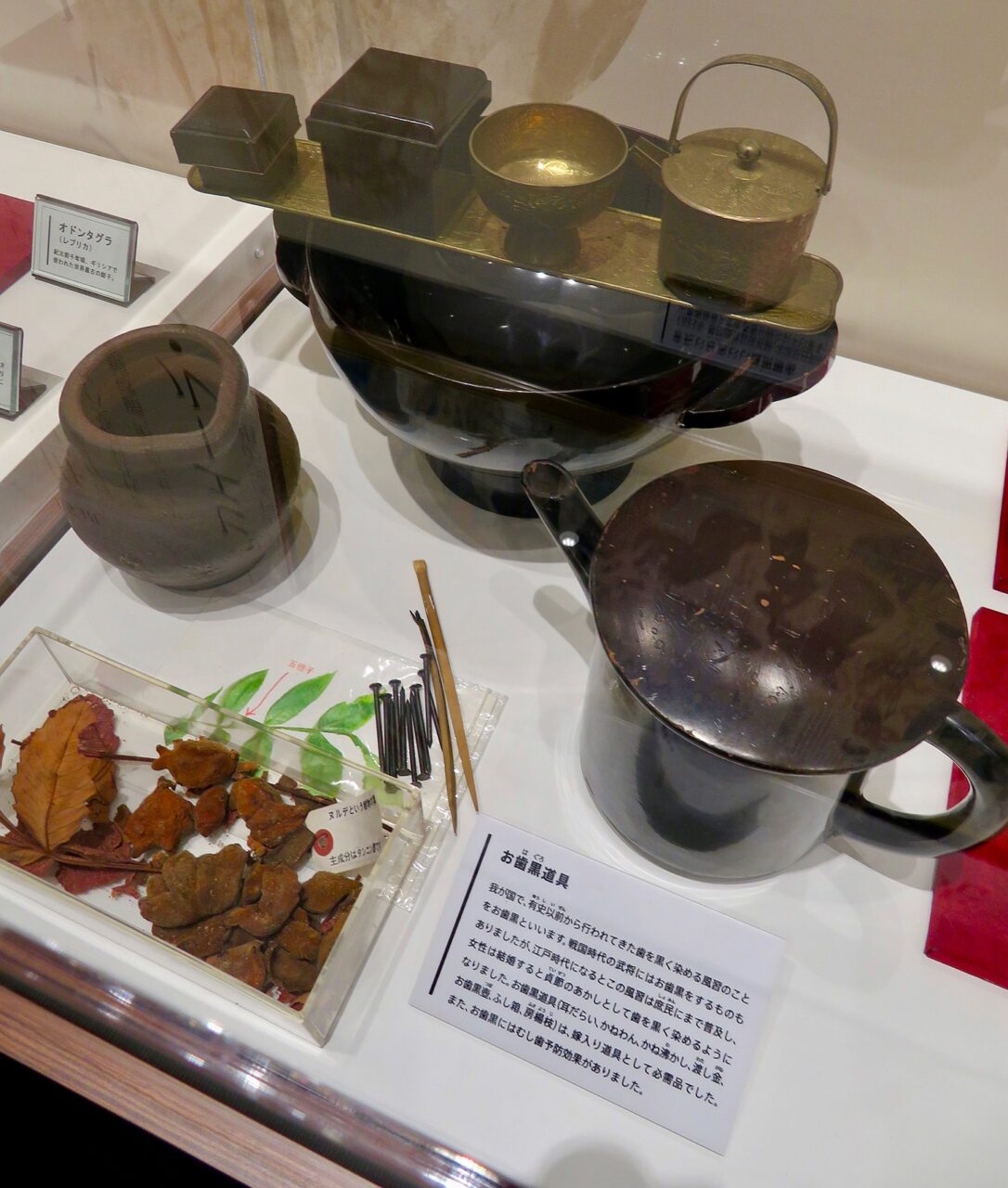
If you visit a lot of museums in Japan you can see a neat little make up set that was used for the ohaguro ritual. There were quite a few instruments needed like, a mirror, of course, a basin and smaller bowl for rinsing your mouth, a container for the kanemizu and one for holding the powdered gallnuts. And don’t forget a tray for holding the various brushes and painting implements. Speaking of brushes, if you were especially glamorous and rich you could use a very fine brush made from the combined feathers of a crane, a pheasant, and a Mandarin duck.
You might be able to guess, but the dye smelled really bad. So bad in fact, that poor wives had to get up before the rest of the family, so they could color their teeth without grossing everyone out. Another two bits of advice, before applying the stinky dye, you should rub something like pomegranate rind over your teeth to help it adhere better. And then after you are done in order to help it dry quickly, go ahead and take some Me Time and smoke on your kiseru pipe for a little bit before the family wakes up.
Ohaguro wasn’t a one time lasts a month kind of thing either. The dye faded quite quickly, actually, and going through the process daily wasn’t unheard of. Which makes you think twice about the whole loyalty symbolism thing.
Other Benefits
And just so you know, ohaguro wasn’t just a beauty standard either. The dye was thought to protect the teeth and in case you did have a cavity or something, it offered immediate pain relief.
Why Why and When Did it Stop?
Well, foreigners didn’t help. When they started to arrive at the end of the Edo Era and beginning of the Meiji Era, and they saw this practice their immediate thought was that it was unattractive and cruel. Unable to see anything beautiful about it, they assumed it was a way to keep married women faithful by making them ugly.
It’s written that when Commodore Perry arrived in Japan he said and I’m paraphrasing here, “Japanese women can read and write and they seem to be knowledgable about many things, I can’t understand why’d they’d paint their teeth black.”
And so the practice was officially banned on February 5th, 1870. Although it didn’t disappear immediately. A two thousand year old custom doesn’t die so easily. There are even posters you can find during this time advertising a fushi powder for women to use instead of the long complicated traditional way. This one could be wiped off easily, too. So maybe if you saw a cop coming or something.
Three years after the official ban, in 1873, the Empress appeared in public with white teeth for the first time. Which was shocking but also did quite a bit to get people to think twice and change their ways.
What is Beauty Anyway?
Okay, before I go, let me have you remember that first image of a woman with blackened teeth, her face and neck painted white, and eyebrows completely shaven. Seeing this today, perhaps a kabuki actor or maiko on the streets of Kyoto, it looks a little unnatural and harsh, some might say spooky. But you have to remember that back in an older Japan, rooms were lit with candles or oil lamps. Walls, floors, ceilings were made of wood, paper, or an earthy-colored sandy substance. In this lighting, having regular skin, didn’t look so nice. But if you were wearing very white makeup, called shironuri, the firelight made your skin look warm and golden, smooth and flawless.
Next, are the shaved eyebrows. That was also a thing. Again nowadays unless penciled in, an eyebrow-less face can have an uncanny creepy look to it. But back then, it was considered beautiful because — and I got this from a Japanese educational TV show that also explained ohaguro. The historian on the show said, it’s from your eyebrows you make most of your expressions and give away all sorts of emotions. If you don’t have eyebrows, again in a gloaming room, you look reserved and refined. Not overly emotional. Like what if this guy your go between chose for you to meet was really gross looking? Having no eyebrows would allow to hide that look of disgust.
As for darkened teeth, it was actually shiny white teeth that were unsettling, possibly because they resembled some wild fanged beast, like oni.
An Old Early Urban Legend
And so I’ll leave you today with a cute misunderstanding that came out in the Meiji Era. An early urban legend, if you will. At the time electricity lines were being hung in bigger cities in Japan and the men doing the work used coal tar to paint them. I’m guessing insulation? Or maybe they were painting the poles? Either way, people saw this strange thing going on and these big buckets of dark liquid being used, and the rumor spread they were using living virgins’ blood. This caused a bit of a panic as you can imagine. The solution is adorable. Young ladies all over started dying their teeth black, plucking their eyebrows, and wearing boring kimono so that they looked like they were married and would avoid getting their blood drained.
Next episode I’ll talk about the yokai who are associated with ohaguro and what we can find there.
Thank you all for listening and supporting the show. I love you patrons. You’re the best. Bye bye

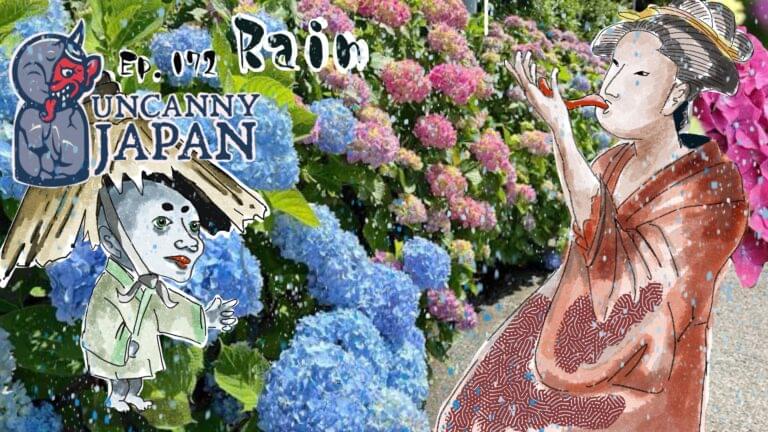
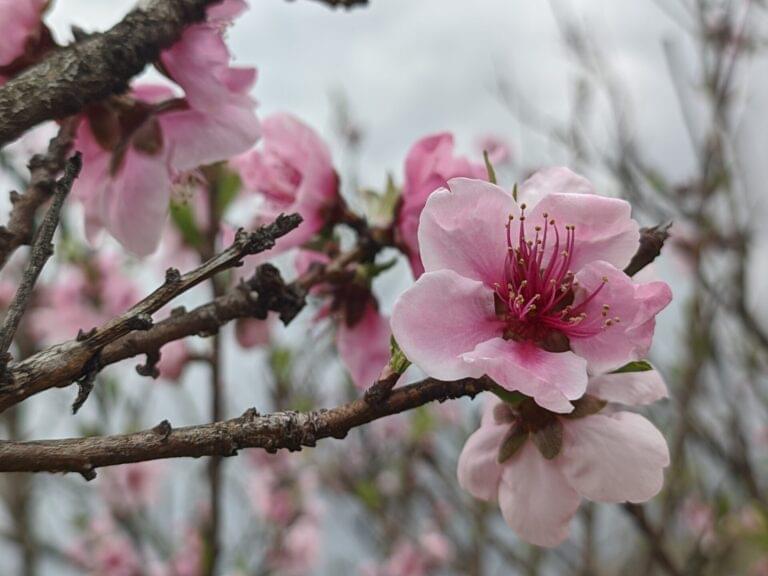
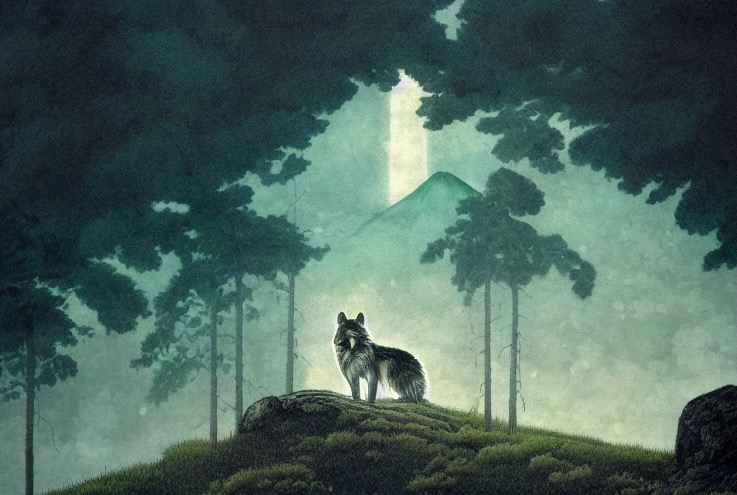
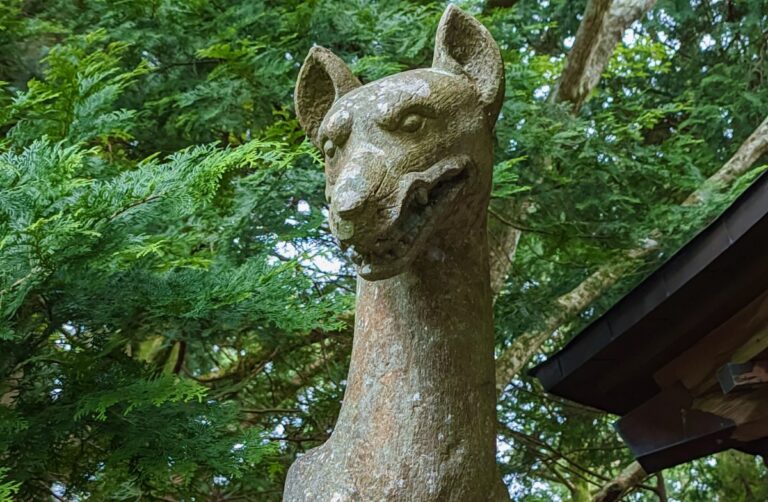


I found the article on Ohaguro to be quite intriguing as it revealed the beauty customs of ancient Japan. It was peculiar to discover that blackening one’s teeth was viewed as a way to enhance one’s appearance, but it was a customary practice that was considered a sign of beauty and maturity. It was also interesting to learn that Ohaguro was not only practiced by women but also by men, and it was a status symbol among the aristocracy. The article also highlighted the cultural significance of Ohaguro and its association with the samurai culture, which was used to distinguish the samurai class from the commoners. However, I am curious about the potential health risks of Ohaguro, as the article only briefly mentioned dental problems and bad breath. I would like to know more about the long-term effects of Ohaguro on oral health. Overall, the article provided an insightful glimpse into the beauty practices of ancient Japan, which was vastly different from modern-day beauty standards.
Christian, I was surprised that men did it, too. I told my Japanese friends and they didn’t know about it either! I guess it’s mostly just thought of as a ‘married woman’ tradition. I didn’t find anything about long-term effects, but I’m curious as well. The liquid painted on was in their mouth, some swallowed for sure. If I find anything, I’ll mention it on a future podcast. Thanks for asking and listening!
I really enjoyed this podcast, I liked the narrating and the story it was very intersting to say the least. I find very funny how odd the beauty standards used to be in the day of old, although I’m sure if I was alive back then I would also find it beautiful. The Ohaguro make up kind of reminds me of emo makeup nodays however the ohaguro was defenitely much more blown out. As of now with modern beauty standards I would probably find myself getting scared of someone wearing the ohaguro make up but I feel like again it’s only becasue of modern beauty standards. You know back then I would probably hvae done ohgaguro myself as dying your teeth black also came with benefits such as helping to not get cavities, so overall back in the day getting this makeup would’ve been a win-win type of thing. I really enjoyed the podcast I hope you make many more such as this one.
Thank you so much for listening and for the comment, Victor. It’s funny to think that people hundreds of years from now might be looking back at emo makeup and going: What were they thinking?